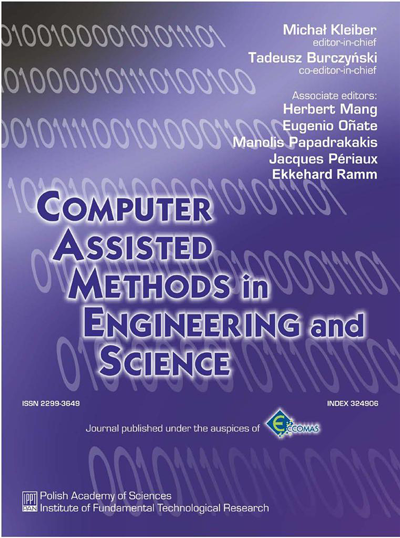Comparison of the ENATE approach and discontinuous Galerkin spectral element method in 1D nonlinear transport equations
Abstract
In this paper a comparison of the performance of two ways of discretizing the nonlinear convection-diffusion equation in a one-dimensional (1D) domain is performed. The two approaches can be considered within the class of high-order methods. The first one is the discontinuous Galerkin method, which has been profusely used to solve general transport equations, either coupled as the Navier-Stokes equations, or on their own. On the other hand, the ENATE procedure (Enhanced Numerical Approximation of a Transport Equation), uses the exact solution to obtain an exact algebraic equation with integral coefficients that link nodal values with a three-point stencil. This paper is the first of thorough assessments of ENATE by comparing it with well-established high-order methods. Several test cases of the steady Burgers' equation with and without source have been chosen for comparison.
*The paper was presented during the Eurotherm Seminar No 109 – Numerical Heat Transfer 2015.
Keywords
one-dimensional transport equation, high-order methods,References
[1] C. Acosta, D.A. Kopriva. Discontinuous Galerkin spectral element approximations on moving meshes. Journal of Computational Physics, 230(5): 1876–1902, 2011.[2] D.N. Arnold, F. Brezzi, B. Cockburn, L.D. Marini. Unified analysis of discontinuous Galerkin methods for elliptic problems. SIAM Journal on Numerical Analysis, 39(5): 1749–1779, 2001.
[3] F. Bassi, A. Crivellini, D.A. Di Pietro, S. Rebay. An artificial compressibility flux for the discontinuous Galerkin solution of the incompressible Navier-Stokes equations. Journal of Computational Physics, 218(2): 794–815, 2006.
[4] F. Bassi, S. Rebay. A high-order accurate discontinuous finite element method for the numerical solution of the compressible Navier-Stokes equations. Journal of Computational Physics, 131(2): 267–279, 1997.
[5] C.E. Baumann. An hp-Adaptive Discontinuous Finite Element Method for Computational Fluid Dynamics. PhD thesis, University of Texas at Austin, 1997.
[6] K. Black. A conservative spectral element method for the approximation of compressible fluid flow. Kybernetika, 35(1): 133–146, 1999.
[7] K. Black. Spectral element approximation of convection-diffusion type problems. Applied Numerical Mathematics, 33(1–4): 373–379, 2000.
[8] C. Canuto, M.Y. Hussaini, A. Quarteroni, T.A. Zang. Spectral Methods. Fundamentals in Single Domains. Springer, Berlin, 2006.
[9] N. Castel, G. Cohen, M. Duruflé. Application of discontinuous Galerkin spectral method on hexahedral elements for aeroacoustic. Journal of Computational Acoustics, 17(2): 175–196, 2009.
[10] S. Deng. Numerical simulation of optical coupling and light propagation in coupled optical resonators with size disorder. Applied Numerical Mathematics, 57(5–7): 475–485, 2007.
[11] S. Deng, W. Cai, V. Astratov. Numerical study of light propagation via whispering gallery modes in microcylinder coupled resonator optical waveguides. Optics Express, 12(26): 6468–6480, 2004.
[12] S. Fagherazzi, D.J. Furbish, P. Rasetarinera, M.Y. Hussaini. Application of the discontinuous spectral Galerkin method to groundwater flow. Advances in Water Resources, 27(2): 129–140, 2004.
[13] S. Fagherazzi, P. Rasetarinera, M.Y. Hussaini. Numerical solution of the dambreak problem with a discontinuous Galerkin method. Journal of Hydraulic Engineering, 130(6): 532–539, 2004.
[14] E. Ferrer. A High Order Discontinuous Galerkin-Fourier Incompressible 3D Navier-Stokes Solver with Rotating Sliding Meshes for Simulating Cross-Flow Turbines. PhD thesis, University of Oxford, 2012.
[15] E. Ferrer, R.H.J. Willden. A high order discontinuous Galerkin finite element solver for the incompressible Navier-Stokes equations. Computers & Fluids, 46(1): 224–230, 2011.
[16] E. Ferrer, R.H.J. Willden. A high order discontinuous Galerkin-Fourier incompressible 3D Navier-Stokes solver with rotating sliding meshes. Journal of Computational Physics, 231(21): 7037–7056, 2012.
[17] F.X. Giraldo, J.S. Hesthaven, T. Warburton. Nodal high-order discontinuous Galerkin methods for the spherical shallow water equations. Journal of Computational Physics, 181(2): 499–525, 2002.
[18] F.X. Giraldo, M. Restelli. A study of spectral element and discontinuous Galerkin methods for the Navier-Stokes equations in nonhydrostatic mesoscale atmospheric modeling: Equation sets and test cases. Journal of Computational Physics, 227(8): 3849–3877, 2008.
[19] G.E. Karniadakis, S. Sherwin. Spectral/hp Element Methods for Computational Fluid Dynamics. Oxford Science Publications, 2005.
[20] M. Kompenhans, G. Rubio, E. Ferrer, E. Valero. Adaptation strategies for high order discontinuous Galerkin methods based on Tau-estimation. Journal of Computational Physics, 306: 216–236, 2016.
[21] M. Kompenhans, G. Rubio, E. Ferrer, E. Valero. Comparisons of p-adaptation strategies based on truncation-and discretisation-errors for high order discontinuous Galerkin methods. Computers & Fluids, 139: 36–46, 2016.
[22] D.A. Kopriva. Metric identities and the discontinuous spectral element method on curvilinear meshes. Journal of Scientific Computing, 26(3): 301–327, 2006.
[23] D.A. Kopriva. Implementing Spectral Methods for Partial Differential Equations: Algorithms for Scientists and Engineers. Springer Science & Business Media, 2009.
[24] D.A. Kopriva, S.L. Woodruff, M.Y. Hussaini. Computation of electromagnetic scattering with a non-conforming discontinuous spectral element method. International Journal for Numerical Methods in Engineering, 53(1): 105–122, 2002.
[25] S. Mao, C.A. Luongo, D.A. Kopriva. Discontinuous Galerkin spectral element simulation of quench propagation in superconducting magnets. IEEE Transactions on Applied Superconductivity, 15(2): 1675–1678, 2005.
[26] A. Pascau. An exact discretization for a transport equation with piecewise-constant coefficients and arbitrary source. Computers and Fluids, 75: 42–50, 2013.
[27] A. Pascau, M. Arici. An accurate discretization for an inhomogeneous transport equation with arbitrary coefficients and source. Computers and Fluids, 125: 101–115, 2016.
[28] P. Rasetarinera, M.Y. Hussaini. An efficient implicit discontinuous spectral Galerkin method. Journal of Computational Physics, 172(2): 718–738, 2001.
[29] P. Rasetarinera, D.A. Kopriva, M.Y. Hussaini. Discontinuous spectral element solution of acoustic radiation from thin airfoils. AIAA Journal, 39(11): 2070–2075, 2001.
[30] W.H. Reed, T.R. Hill. Triangular Mesh Methods for the Neutron Transport Equation. Los Alamos Report LA-UR-73-479, 1973.
[31] M. Restelli, F.X. Giraldo. A conservative discontinuous Galerkin semi-implicit formulation for the Navier-Stokes equations in nonhydrostatic mesoscale modeling. SIAM Journal on Scientific Computing, 31(3):2231–2257, 2009.
[32] D. Stanescu, M. Hussaini, F. Farassat. Aircraft engine noise scattering – A discontinuous spectral element approach. [In:] 40th AIAA Aerospace Sciences Meeting & Exhibit, Reston, Virigina, American Institute of Aeronautics and Astronautics, 2012.
[33] D. Stanescu, J. Xu, M.Y. Hussaini, F. Farassat. Computation of engine noise propagation and scattering off an aircraft. International Journal of Aeroacoustics, 1(4): 403–420, 2009.
[34] E.F. Toro. Riemann Solvers and Numerical Methods for Fluid Dynamics. A Practical Introduction. Springer, 2009.




